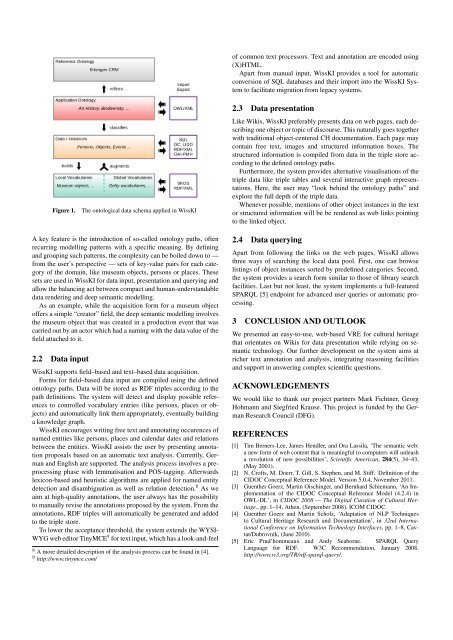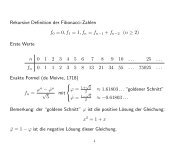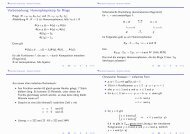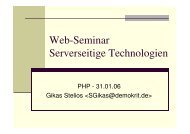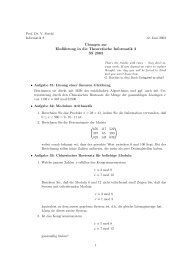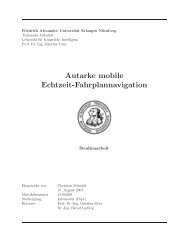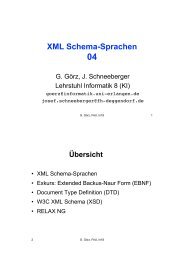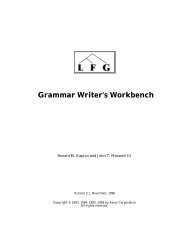WissKI: A Virtual Research Environment for Cultural Heritage
WissKI: A Virtual Research Environment for Cultural Heritage
WissKI: A Virtual Research Environment for Cultural Heritage
Create successful ePaper yourself
Turn your PDF publications into a flip-book with our unique Google optimized e-Paper software.
of common text processors. Text and annotation are encoded using(X)HTML.Apart from manual input, <strong>WissKI</strong> provides a tool <strong>for</strong> automaticconversion of SQL databases and their import into the <strong>WissKI</strong> Systemto facilitate migration from legacy systems.Figure 1.The ontological data schema applied in <strong>WissKI</strong>2.3 Data presentationLike Wikis, <strong>WissKI</strong> preferably presents data on web pages, each describingone object or topic of discourse. This naturally goes togetherwith traditional object-centered CH documentation. Each page maycontain free text, images and structured in<strong>for</strong>mation boxes. Thestructured in<strong>for</strong>mation is compiled from data in the triple store accordingto the defined ontology paths.Furthermore, the system provides alternative visualisations of thetriple data like triple tables and several interactive graph representations.Here, the user may “look behind the ontology paths” andexplore the full depth of the triple data.Whenever possible, mentions of other object instances in the textor structured in<strong>for</strong>mation will be be rendered as web links pointingto the linked object.A key feature is the introduction of so-called ontology paths, oftenrecurring modelling patterns with a specific meaning. By definingand grouping such patterns, the complexity can be boiled down to —from the user’s perspective — sets of key-value pairs <strong>for</strong> each categoryof the domain, like museum objects, persons or places. Thesesets are used in <strong>WissKI</strong> <strong>for</strong> data input, presentation and querying andallow the balancing act between compact and human-understandabledata rendering and deep semantic modelling.As an example, while the acquisition <strong>for</strong>m <strong>for</strong> a museum objectoffers a simple “creator” field, the deep semantic modelling involvesthe museum object that was created in a production event that wascarried out by an actor which had a naming with the data value of thefield attached to it.2.2 Data input<strong>WissKI</strong> supports field–based and text–based data acquisition.Forms <strong>for</strong> field–based data input are compiled using the definedontology paths. Data will be stored as RDF triples according to thepath definitions. The system will detect and display possible referencesto controlled vocabulary entries (like persons, places or objects)and automatically link them appropriately, eventually buildinga knowledge graph.<strong>WissKI</strong> encourages writing free text and annotating occurences ofnamed entities like persons, places and calendar dates and relationsbetween the entities. <strong>WissKI</strong> assists the user by presenting annotationproposals based on an automatic text analysis. Currently, Germanand English are supported. The analysis process involves a preprocessingphase with lemmatisation and POS-tagging. Afterwardslexicon-based and heuristic algorithms are applied <strong>for</strong> named entitydetection and disambiguation as well as relation detection. 8 As weaim at high-quality annotations, the user always has the possibilityto manually revise the annotations proposed by the system. From theannotations, RDF triples will automatically be generated and addedto the triple store.To lower the acceptance threshold, the system extends the WYSI-WYG web editor TinyMCE 9 <strong>for</strong> text input, which has a look-and-feel8 A more detailed description of the analysis process can be found in [4].9 http://www.tinymce.com/2.4 Data queryingApart from following the links on the web pages, <strong>WissKI</strong> allowsthree ways of searching the local data pool. First, one can browselistings of object instances sorted by predefined categories. Second,the system provides a search <strong>for</strong>m similar to those of library searchfacilities. Last but not least, the system implements a full-featuredSPARQL [5] endpoint <strong>for</strong> advanced user queries or automatic processing.3 CONCLUSION AND OUTLOOKWe presented an easy-to-use, web-based VRE <strong>for</strong> cultural heritagethat orientates on Wikis <strong>for</strong> data presentation while relying on semantictechnology. Our further development on the system aims atricher text annotation and analysis, integrating reasoning facilitiesand support in answering complex scientific questions.ACKNOWLEDGEMENTSWe would like to thank our project partners Mark Fichtner, GeorgHohmann and Siegfried Krause. This project is funded by the German<strong>Research</strong> Council (DFG).REFERENCES[1] Tim Berners-Lee, James Hendler, and Ora Lassila, ‘The semantic web:a new <strong>for</strong>m of web content that is meaningful to computers will unleasha revolution of new possibilities’, Scientific American, 284(5), 34–43,(May 2001).[2] N. Crofts, M. Doerr, T. Gill, S. Stephen, and M. Stiff. Definition of theCIDOC Conceptual Reference Model. Version 5.0.4, November 2011.[3] Guenther Goerz, Martin Oischinger, and Bernhard Schiemann, ‘An Implementationof the CIDOC Conceptual Reference Model (4.2.4) inOWL-DL’, in CIDOC 2008 — The Digital Curation of <strong>Cultural</strong> <strong>Heritage</strong>.,pp. 1–14, Athen, (September 2008). ICOM CIDOC.[4] Guenther Goerz and Martin Scholz, ‘Adaptation of NLP Techniquesto <strong>Cultural</strong> <strong>Heritage</strong> <strong>Research</strong> and Documentation’, in 32nd InternationalConference on In<strong>for</strong>mation Technology Interfaces, pp. 1–8, Cavtat/Dubrovnik,(June 2010).[5] Eric Prud’hommeaux and Andy Seaborne. SPARQL QueryLanguage <strong>for</strong> RDF. W3C Recommendation, January 2008.http://www.w3.org/TR/rdf-sparql-query/.


